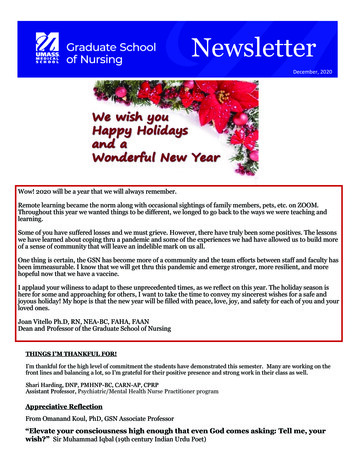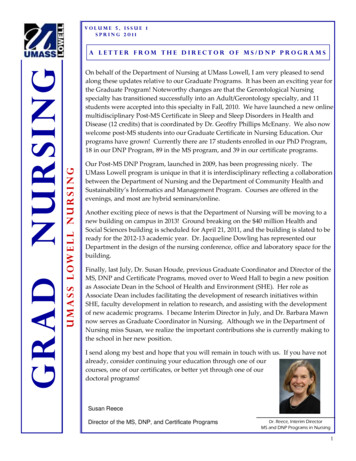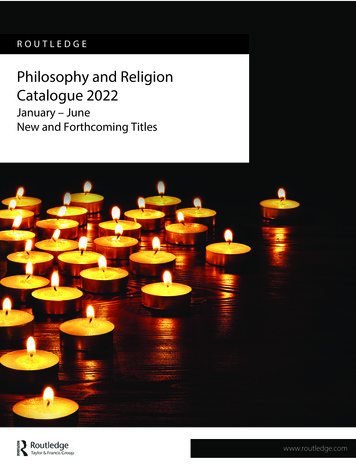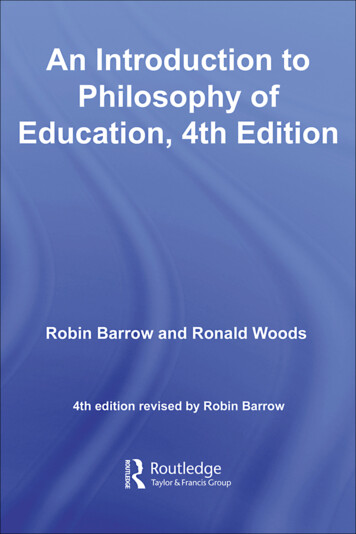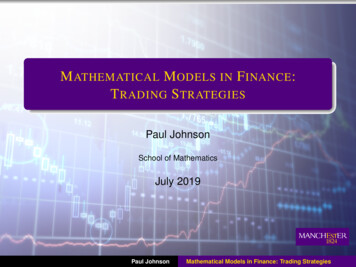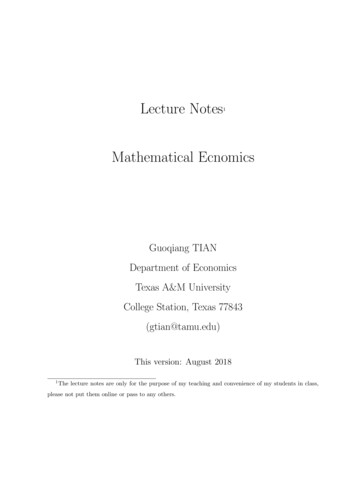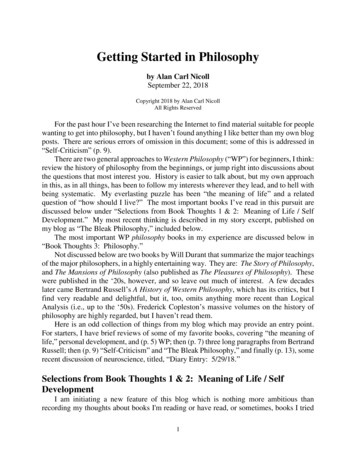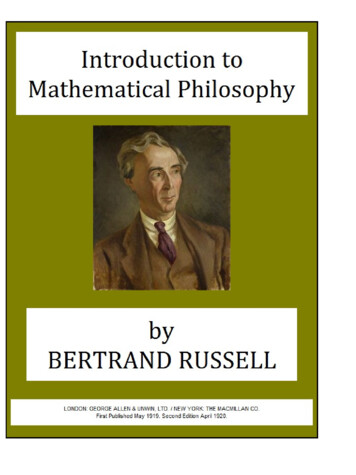
Transcription
Introduction to MathematicalPhilosophybyBertrand RussellOriginally published byGeorge Allen & Unwin, Ltd., London. May .Online Corrected Edition version . (February , ),based on the “second edition” (second printing) of April , incorporating additional corrections,marked in green.
[Russell’s blurb from the original dustcover:]This book is intended for those who have no previous acquaintance with the topics of which it treats,and no more knowledge of mathematics than canbe acquired at a primary school or even at Eton. Itsets forth in elementary form the logical definitionof number, the analysis of the notion of order, themodern doctrine of the infinite, and the theory ofdescriptions and classes as symbolic fictions. Themore controversial and uncertain aspects of the subject are subordinated to those which can by now beregarded as acquired scientific knowledge. Theseare explained without the use of symbols, but insuch a way as to give readers a general understanding of the methods and purposes of mathematicallogic, which, it is hoped, will be of interest not onlyto those who wish to proceed to a more serious studyof the subject, but also to that wider circle who feel adesire to know the bearings of this important modern science.
ContentsContents . . . . . . . . . . . . . . . . . . . . . ivPreface . . . . . . . . . . . . . . . . . . . . . . viEditor’s Note . . . . . . . . . . . . . . . . . . . ixI. The Series of Natural Numbers . . . II. Definition of Number . . . . . . . . . III. Finitude and Mathematical Induction IV. The Definition of Order . . . . . . . V. Kinds of Relations . . . . . . . . . . . VI. Similarity of Relations . . . . . . . . VII. Rational, Real, and Complex Numbers VIII. Infinite Cardinal Numbers . . . . . . IX. Infinite Series and Ordinals . . . . . X. Limits and Continuity . . . . . . . . XI. Limits and Continuity of Functions . XII. Selections and the Multiplicative Axiom . . . . . . . . . . . . . . . . . . . .
XIII. The Axiom of Infinity and LogicalTypes . . . . . . . . . . . . . . . . . . XIV. Incompatibility and the Theory of Deduction . . . . . . . . . . . . . . . . . XV. Propositional Functions . . . . . . . XVI. Descriptions . . . . . . . . . . . . . . XVII. Classes . . . . . . . . . . . . . . . . . XVIII. Mathematics and Logic . . . . . . . . Index . . . . . . . . . . . . . . . . . . . . . . . Appendix: Changes to Online Edition . . . .
PrefaceThis book is intended essentially as an “Introduc- vtion,” and does not aim at giving an exhaustivediscussion of the problems with which it deals. Itseemed desirable to set forth certain results, hitherto only available to those who have mastered logical symbolism, in a form offering the minimum ofdifficulty to the beginner. The utmost endeavourhas been made to avoid dogmatism on such questions as are still open to serious doubt, and thisendeavour has to some extent dominated the choiceof topics considered. The beginnings of mathematical logic are less definitely known than its later portions, but are of at least equal philosophical interest.Much of what is set forth in the following chaptersis not properly to be called “philosophy,” thoughthe matters concerned were included in philosophyso long as no satisfactory science of them existed.The nature of infinity and continuity, for example,
belonged in former days to philosophy, but belongsnow to mathematics. Mathematical philosophy, inthe strict sense, cannot, perhaps, be held to includesuch definite scientific results as have been obtainedin this region; the philosophy of mathematics willnaturally be expected to deal with questions on thefrontier of knowledge, as to which comparative certainty is not yet attained. But speculation on suchquestions is hardly likely to be fruitful unless themore scientific parts of the principles of mathematics are known. A book dealing with those parts may,therefore, claim to be an introduction to mathematical philosophy, though it can hardly claim, exceptwhere it steps outside its province, to be actuallydealing with a part of philosophy. It does deal, however, with a body of knowledge which, to those viwho accept it, appears to invalidate much traditional philosophy, and even a good deal of what iscurrent in the present day. In this way, as well as byits bearing on still unsolved problems, mathematical logic is relevant to philosophy. For this reason, aswell as on account of the intrinsic importance of thesubject, some purpose may be served by a succinctaccount of the main results of mathematical logic ina form requiring neither a knowledge of mathematics nor an aptitude for mathematical symbolism.
Here, however, as elsewhere, the method is moreimportant than the results, from the point of viewof further research; and the method cannot well beexplained within the framework of such a book asthe following. It is to be hoped that some readersmay be sufficiently interested to advance to a studyof the method by which mathematical logic can bemade helpful in investigating the traditional problems of philosophy. But that is a topic with whichthe following pages have not attempted to deal.BERTRAND RUSSELL.
Editor’s Note[The note below was written by J. H. Muirhead, viiLL.D., editor of the Library of Philosophy series inwhich Introduction to Mathematical Philosophy wasoriginally published.]Those who, relying on the distinction between Mathematical Philosophy and the Philosophy of Mathematics, think that this book is out of place in thepresent Library, may be referred to what the author himself says on this head in the Preface. It isnot necessary to agree with what he there suggestsas to the readjustment of the field of philosophyby the transference from it to mathematics of suchproblems as those of class, continuity, infinity, inorder to perceive the bearing of the definitions anddiscussions that follow on the work of “traditionalphilosophy.” If philosophers cannot consent to relegate the criticism of these categories to any of the
special sciences, it is essential, at any rate, that theyshould know the precise meaning that the science ofmathematics, in which these concepts play so large apart, assigns to them. If, on the other hand, there bemathematicians to whom these definitions and discussions seem to be an elaboration and complicationof the simple, it may be well to remind them fromthe side of philosophy that here, as elsewhere, apparent simplicity may conceal a complexity whichit is the business of somebody, whether philosopheror mathematician, or, like the author of this volume,both in one, to unravel.
Chapter IThe Series of Natural NumbersMathematics is a study which, when we start from its most familiar portions, may be pursued in eitherof two opposite directions. The more familiar direction is constructive, towards gradually increasingcomplexity: from integers to fractions, real numbers, complex numbers; from addition and multiplication to differentiation and integration, and on tohigher mathematics. The other direction, which isless familiar, proceeds, by analysing, to greater andgreater abstractness and logical simplicity; insteadof asking what can be defined and deduced fromwhat is assumed to begin with, we ask instead whatmore general ideas and principles can be found, interms of which what was our starting-point can bedefined or deduced. It is the fact of pursuing thisopposite direction that characterises mathematical
philosophy as opposed to ordinary mathematics.But it should be understood that the distinctionis one, not in the subject matter, but in the stateof mind of the investigator. Early Greek geometers, passing from the empirical rules of Egyptianland-surveying to the general propositions by whichthose rules were found to be justifiable, and thenceto Euclid’s axioms and postulates, were engagedin mathematical philosophy, according to the abovedefinition; but when once the axioms and postulateshad been reached, their deductive employment, aswe find it in Euclid, belonged to mathematics in the ordinary sense. The distinction between mathe- matics and mathematical philosophy is one whichdepends upon the interest inspiring the research,and upon the stage which the research has reached;not upon the propositions with which the researchis concerned.We may state the same distinction in anotherway. The most obvious and easy things in mathematics are not those that come logically at the beginning; they are things that, from the point of view oflogical deduction, come somewhere in the middle.Just as the easiest bodies to see are those that areneither very near nor very far, neither very small norvery great, so the easiest conceptions to grasp are
those that are neither very complex nor very simple(using “simple” in a logical sense). And as we needtwo sorts of instruments, the telescope and the microscope, for the enlargement of our visual powers,so we need two sorts of instruments for the enlargement of our logical powers, one to take us forwardto the higher mathematics, the other to take us backward to the logical foundations of the things that weare inclined to take for granted in mathematics. Weshall find that by analysing our ordinary mathematical notions we acquire fresh insight, new powers,and the means of reaching whole new mathematicalsubjects by adopting fresh lines of advance after ourbackward journey. It is the purpose of this book toexplain mathematical philosophy simply and untechnically, without enlarging upon those portionswhich are so doubtful or difficult that an elementary treatment is scarcely possible. A full treatmentwill be found in Principia Mathematica; the treatment in the present volume is intended merely asan introduction.To the average educated person of the presentday, the obvious starting-point of mathematics Cambridge University Press, vol. i., ; vol. ii., ; vol.iii., . By Whitehead and Russell.
would be the series of whole numbers, , , , , . . . etc. Probably only a person with some mathematical knowledge would think of beginning with insteadof with , but we will presume this degree of knowledge; we will take as our starting-point the series: , , , , . . . n, n , . . .and it is this series that we shall mean when wespeak of the “series of natural numbers.”It is only at a high stage of civilisation that wecould take this series as our starting-point. It musthave required many ages to discover that a brace ofpheasants and a couple of days were both instancesof the number : the degree of abstraction involvedis far from easy. And the discovery that is a number must have been difficult. As for , it is a veryrecent addition; the Greeks and Romans had nosuch digit. If we had been embarking upon mathematical philosophy in earlier days, we should havehad to start with something less abstract than theseries of natural numbers, which we should reachas a stage on our backward journey. When the logical foundations of mathematics have grown morefamiliar, we shall be able to start further back, at
what is now a late stage in our analysis. But forthe moment the natural numbers seem to representwhat is easiest and most familiar in mathematics.But though familiar, they are not understood.Very few people are prepared with a definition ofwhat is meant by “number,” or “ ,” or “ .” It isnot very difficult to see that, starting from , anyother of the natural numbers can be reached by repeated additions of , but we shall have to definewhat we mean by “adding ,” and what we mean by“repeated.” These questions are by no means easy.It was believed until recently that some, at least, ofthese first notions of arithmetic must be acceptedas too simple and primitive to be defined. Since allterms that are defined are defined by means of otherterms, it is clear that human knowledge must always be content to accept some terms as intelligiblewithout definition, in order to have a starting-point for its definitions. It is not clear that there must beterms which are incapable of definition: it is possiblethat, however far back we go in defining, we alwaysmight go further still. On the other hand, it is alsopossible that, when analysis has been pushed farenough, we can reach terms that really are simple,and therefore logically incapable of the sort of definition that consists in analysing. This is a question
which it is not necessary for us to decide; for ourpurposes it is sufficient to observe that, since humanpowers are finite, the definitions known to us mustalways begin somewhere, with terms undefined forthe moment, though perhaps not permanently.All traditional pure mathematics, including analytical geometry, may be regarded as consistingwholly of propositions about the natural numbers.That is to say, the terms which occur can be definedby means of the natural numbers, and the propositions can be deduced from the properties of thenatural numbers—with the addition, in each case,of the ideas and propositions of pure logic.That all traditional pure mathematics can bederived from the natural numbers is a fairly recent discovery, though it had long been suspected.Pythagoras, who believed that not only mathematics, but everything else could be deduced from numbers, was the discoverer of the most serious obstaclein the way of what is called the “arithmetising” ofmathematics. It was Pythagoras who discovered theexistence of incommensurables, and, in particular,the incommensurability of the side of a square andthe diagonal. If the length of the side is inch, thenumber of inches in the diagonal is the square rootof , which appeared not to be a number at all. The
problem thus raised was solved only in our ownday, and was only solved completely by the help ofthe reduction of arithmetic to logic, which will beexplained in following chapters. For the present, weshall take for granted the arithmetisation of mathematics, though this was a feat of the very greatestimportance. Having reduced all traditional pure mathemat- ics to the theory of the natural numbers, the nextstep in logical analysis was to reduce this theoryitself to the smallest set of premisses and undefinedterms from which it could be derived. This workwas accomplished by Peano. He showed that the entire theory of the natural numbers could be derivedfrom three primitive ideas and five primitive propositions in addition to those of pure logic. These threeideas and five propositions thus became, as it were,hostages for the whole of traditional pure mathematics. If they could be defined and proved in termsof others, so could all pure mathematics. Their logical “weight,” if one may use such an expression,is equal to that of the whole series of sciences thathave been deduced from the theory of the naturalnumbers; the truth of this whole series is assured ifthe truth of the five primitive propositions is guaranteed, provided, of course, that there is nothing
erroneous in the purely logical apparatus which isalso involved. The work of analysing mathematics isextraordinarily facilitated by this work of Peano’s.The three primitive ideas in Peano’s arithmeticare: , number, successor.By “successor” he means the next number in thenatural order. That is to say, the successor of is ,the successor of is , and so on. By “number” hemeans, in this connection, the class of the naturalnumbers. He is not assuming that we know allthe members of this class, but only that we knowwhat we mean when we say that this or that is anumber, just as we know what we mean when wesay “Jones is a man,” though we do not know allmen individually.The five primitive propositions which Peano assumes are:( ) is a number.( ) The successor of any number is a number.( ) No two numbers have the same successor. ( ) is not the successor of any number. We shall use “number” in this sense in the present chapter.Afterwards the word will be used in a more general sense.
( ) Any property which belongs to , and also tothe successor of every number which has theproperty, belongs to all numbers.The last of these is the principle of mathematicalinduction. We shall have much to say concerning mathematical induction in the sequel; for thepresent, we are concerned with it only as it occursin Peano’s analysis of arithmetic.Let us consider briefly the kind of way in whichthe theory of the natural numbers results from thesethree ideas and five propositions. To begin with, wedefine as “the successor of ,” as “the successorof ,” and so on. We can obviously go on as longas we like with these definitions, since, in virtue of( ), every number that we reach will have a successor, and, in virtue of ( ), this cannot be any of thenumbers already defined, because, if it were, twodifferent numbers would have the same successor;and in virtue of ( ) none of the numbers we reach inthe series of successors can be . Thus the series ofsuccessors gives us an endless series of continuallynew numbers. In virtue of ( ) all numbers comein this series, which begins with and travels onthrough successive successors: for (a) belongs tothis series, and (b) if a number n belongs to it, sodoes its successor, whence, by mathematical induc-
tion, every number belongs to the series.Suppose we wish to define the sum of two numbers. Taking any number m, we define m as m,and m (n ) as the successor of m n. In virtueof ( ) this gives a definition of the sum of m andn, whatever number n may be. Similarly we candefine the product of any two numbers. The readercan easily convince himself that any ordinary elementary proposition of arithmetic can be provedby means of our five premisses, and if he has anydifficulty he can find the proof in Peano.It is time now to turn to the considerations whichmake it necessary to advance beyond the standpoint of Peano, who represents the last perfection of the “arithmetisation” of mathematics, to that ofFrege, who first succeeded in “logicising” mathematics, i.e. in reducing to logic the arithmeticalnotions which his predecessors had shown to besufficient for mathematics. We shall not, in thischapter, actually give Frege’s definition of numberand of particular numbers, but we shall give someof the reasons why Peano’s treatment is less finalthan it appears to be.In the first place, Peano’s three primitive ideas—namely, “ ,” “number,” and “successor”—are capable of an infinite number of different interpre-
tations, all of which will satisfy the five primitivepropositions. We will give some examples.( ) Let “ ” be taken to mean , and let “number” be taken to mean the numbers from onward in the series of natural numbers. Then all ourprimitive propositions are satisfied, even the fourth,for, though is the successor of , is not a“number” in the sense which we are now giving tothe word “number.” It is obvious that any numbermay be substituted for in this example.( ) Let “ ” have its usual meaning, but let “number” mean what we usually call “even numbers,”and let the “successor” of a number be what resultsfrom adding two to it. Then “ ” will stand for thenumber two, “ ” will stand for the number four,and so on; the series of “numbers” now will be , two, four, six, eight . . .All Peano’s five premisses are satisfied still.( ) Let “ ” mean the number one, let “number”mean the set , , , , ,.and let “successor” mean “half.” Then all Peano’sfive axioms will be true of this set.
It is clear that such examples might be multiplied indefinitely. In fact, given any seriesx , x , x , x , . . . xn , . . . which is endless, contains no repetitions, has a be- ginning, and has no terms that cannot be reachedfrom the beginning in a finite number of steps, wehave a set of terms verifying Peano’s axioms. Thisis easily seen, though the formal proof is somewhatlong. Let “ ” mean x , let “number” mean the wholeset of terms, and let the “successor” of xn mean xn .Then( ) “ is a number,” i.e. x is a member of theset.( ) “The successor of any number is a number,”i.e. taking any term xn in the set, xn is also in theset.( ) “No two numbers have the same successor,”i.e. if xm and xn are two different members of theset, xm and xn are different; this results from thefact that (by hypothesis) there are no repetitions inthe set.( ) “ is not the successor of any number,” i.e. noterm in the set comes before x .( ) This becomes: Any property which belongsto x , and belongs to xn provided it belongs to xn ,
belongs to all the x’s.This follows from the corresponding propertyfor numbers.A series of the formx , x , x , . . . xn , . . .in which there is a first term, a successor to eachterm (so that there is no last term), no repetitions,and every term can be reached from the start in afinite number of steps, is called a progression. Progressions are of great importance in the principles ofmathematics. As we have just seen, every progression verifies Peano’s five axioms. It can be proved,conversely, that every series which verifies Peano’sfive axioms is a progression. Hence these five axioms may be used to define the class of progressions: “progressions” are “those series which verifythese five axioms.” Any progression may be takenas the basis of pure mathematics: we may give thename “ ” to its first term, the name “number” to thewhole set of its terms, and the name “successor” tothe next in the progression. The progression neednot be composed of numbers: it may be composed of points in space, or moments of time, or any otherterms of which there is an infinite supply. Eachdifferent progression will give rise to a different in-
terpretation of all the propositions of traditionalpure mathematics; all these possible interpretationswill be equally true.In Peano’s system there is nothing to enable us todistinguish between these different interpretationsof his primitive ideas. It is assumed that we knowwhat is meant by “ ,” and that we shall not supposethat this symbol means or Cleopatra’s Needleor any of the other things that it might mean.This point, that “ ” and “number” and “successor” cannot be defined by means of Peano’s fiveaxioms, but must be independently understood, isimportant. We want our numbers not merely to verify mathematical formulæ, but to apply in the rightway to common objects. We want to have ten fingersand two eyes and one nose. A system in which “ ”meant , and “ ” meant , and so on, might beall right for pure mathematics, but would not suitdaily life. We want “ ” and “number” and “successor” to have meanings which will give us the rightallowance of fingers and eyes and noses. We havealready some knowledge (though not sufficientlyarticulate or analytic) of what we mean by “ ” and“ ” and so on, and our use of numbers in arithmeticmust conform to this knowledge. We cannot securethat this shall be the case by Peano’s method; all
that we can do, if we adopt his method, is to say “weknow what we mean by ‘ ’ and ‘number’ and ‘successor,’ though we cannot explain what we mean interms of other simpler concepts.” It is quite legitimate to say this when we must, and at some pointwe all must; but it is the object of mathematical philosophy to put off saying it as long as possible. Bythe logical theory of arithmetic we are able to put itoff for a very long time.It might be suggested that, instead of settingup “ ” and “number” and “successor” as terms ofwhich we know the meaning although we cannotdefine them, we might let them stand for any three terms that verify Peano’s five axioms. They will thenno longer be terms which have a meaning that isdefinite though undefined: they will be “variables,”terms concerning which we make certain hypotheses, namely, those stated in the five axioms, butwhich are otherwise undetermined. If we adopt thisplan, our theorems will not be proved concerningan ascertained set of terms called “the natural numbers,” but concerning all sets of terms having certainproperties. Such a procedure is not fallacious; indeed for certain purposes it represents a valuablegeneralisation. But from two points of view it failsto give an adequate basis for arithmetic. In the first
place, it does not enable us to know whether thereare any sets of terms verifying Peano’s axioms; itdoes not even give the faintest suggestion of anyway of discovering whether there are such sets. Inthe second place, as already observed, we want ournumbers to be such as can be used for countingcommon objects, and this requires that our numbers should have a definite meaning, not merely thatthey should have certain formal properties. Thisdefinite meaning is defined by the logical theory ofarithmetic.
Chapter IIDefinition of NumberThe question “What is a number?” is one which has been often asked, but has only been correctlyanswered in our own time. The answer was givenby Frege in , in his Grundlagen der Arithmetik. Although this book is quite short, not difficult, andof the very highest importance, it attracted almostno attention, and the definition of number which itcontains remained practically unknown until it wasrediscovered by the present author in .In seeking a definition of number, the first thingto be clear about is what we may call the grammar ofour inquiry. Many philosophers, when attemptingto define number, are really setting to work to defineplurality, which is quite a different thing. Number is The same answer is given more fully and with more development in his Grundgesetze der Arithmetik, vol. i., .
what is characteristic of numbers, as man is what ischaracteristic of men. A plurality is not an instanceof number, but of some particular number. A trio ofmen, for example, is an instance of the number ,and the number is an instance of number; but thetrio is not an instance of number. This point mayseem elementary and scarcely worth mentioning;yet it has proved too subtle for the philosophers,with few exceptions.A particular number is not identical with anycollection of terms having that number: the number is not identical with the trio consisting of Brown, Jones, and Robinson. The number is somethingwhich all trios have in common, and which distinguishes them from other collections. A numberis something that characterises certain collections,namely, those that have that number.Instead of speaking of a “collection,” we shall asa rule speak of a “class,” or sometimes a “set.” Otherwords used in mathematics for the same thing are“aggregate” and “manifold.” We shall have much tosay later on about classes. For the present, we willsay as little as possible. But there are some remarksthat must be made immediately.A class or collection may be defined in two waysthat at first sight seem quite distinct. We may enu-
merate its members, as when we say, “The collectionI mean is Brown, Jones, and Robinson.” Or we maymention a defining property, as when we speak of“mankind” or “the inhabitants of London.” The definition which enumerates is called a definition by“extension,” and the one which mentions a definingproperty is called a definition by “intension.” Ofthese two kinds of definition, the one by intension islogically more fundamental. This is shown by twoconsiderations: ( ) that the extensional definitioncan always be reduced to an intensional one; ( ) thatthe intensional one often cannot even theoreticallybe reduced to the extensional one. Each of thesepoints needs a word of explanation.( ) Brown, Jones, and Robinson all of them possess a certain property which is possessed by nothing else in the whole universe, namely, the propertyof being either Brown or Jones or Robinson. Thisproperty can be used to give a definition by intension of the class consisting of Brown and Jones andRobinson. Consider such a formula as “x is Brownor x is Jones or x is Robinson.” This formula willbe true for just three x’s, namely, Brown and Jonesand Robinson. In this respect it resembles a cubicequation with its three roots. It may be taken asassigning a property common to the members of the
class consisting of these three men, and peculiar to them. A similar treatment can obviously be appliedto any other class given in extension.( ) It is obvious that in practice we can oftenknow a great deal about a class without being ableto enumerate its members. No one man could actually enumerate all men, or even all the inhabitantsof London, yet a great deal is known about each ofthese classes. This is enough to show that definitionby extension is not necessary to knowledge about aclass. But when we come to consider infinite classes,we find that enumeration is not even theoreticallypossible for beings who only live for a finite time.We cannot enumerate all the natural numbers: theyare , , , , and so on. At some point we mustcontent ourselves with “and so on.” We cannot enumerate all fractions or all irrational numbers, or allof any other infinite collection. Thus our knowledgein regard to all such collections can only be derivedfrom a definition by intension.These remarks are relevant, when we are seekingthe definition of number, in three different ways.In the first place, numbers themselves form an infinite collection, and cannot therefore be defined byenumeration. In the second place, the collectionshaving a given number of terms themselves presum-
ably form an infinite collection: it is to be presumed,for example, that there are an infinite collection oftrios in the world, for if this were not the case thetotal number of things in the world would be finite, which, though possible, seems unlikely. In thethird place, we wish to define “number” in such away that infinite numbers may be possible; thus wemust be able to speak of the number of terms inan infinite collection, and such a collection must bedefined by intension, i.e. by a property common toall its members and
Introduction to Mathematical Philosophy by Bertrand Russell Originally published by George Allen & Unwin, Ltd., London. May 1919. Online Corrected Edition version 1:0 (February 5, 2010),
